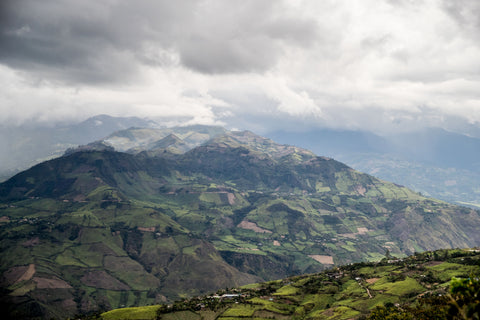Imagine an active volcano. Prehistorically ancient, towering, billows of white smoke engulfing its peak. Imagine living right next to it, and the vast natural park that surrounds it. Spending your childhood running through the forests, sharing meals in the open sky under the shade of rolling mountainsides, raising your family in the sanctuary of a narrow valley. Try hard enough, imagine hard enough, and you might find yourself in Consacá, a small town in Colombia’s Nariño district, in the country's deep south-west.

Misty Andean peaks in Galeras, the natural park at the outskirts of Consacá
One of the largest coffee-producing municipalities in Colombia, the world’s second-largest coffee producer, Consacá enjoys remarkably ideal growing conditions: volcanic, nutrient-rich soil; relatively low levels of humidity; moderate temperatures, ranging between 18-24 degrees Celsius year-round; and a wind-sheltered high-altitude environment, perfect for drying coffee cherries out in the open. This perfect agronomical cocktail is owed not only to the Galeras volcano, but also to the municipality’s proximity to the imposing peaks of the Andean mountain range, whose unique geography allows for Consacá’s coffee to be cultivated in extremely high altitudes; some farms are located as high as 2300 meters above sea level.
But living in the shadow of Colombia’s most active volcano is not without its challenges. The mountain has spurted out smoke and lava on several occasions in recent years, and one of its latest eruptions, in 2010, led to the evacuation of 8000 of the area’s inhabitants. Still, Consacà’s residents consider themselves not only fortunate to be enjoying the area’s agricultural benefits, but also as being deeply tied to the volcano who looms above their lands. The township also prides itself for its significance in Colombian history - it was the ground where the locally-renowned ‘Battle of Bombona’ took place in 1822 between the forces of national hero Simon Bolivar and the royal Spanish army.

Mountain vistas and farms way up in the clouds of Nariño
We were introduced to the unique coffees of the area by our friends at Azahar, whose approach to exporting coffee from Colombia is not one you come across every day. Their passion to promote high-quality coffee consumption in the country itself, rather than just exporting all of the best lots to foreign markets, is an important step towards establishing a stronger, healthier coffee industry in Colombia.
The prototypical Consacá cup is characterized by having distinct acidity, medium body, and a well-balanced flavor profile. The typical regional coffee is also comprised of several small lots of Colombia, Castillo, and Caturra varietals - all cultivated, harvested and processed by local smallholder farmers and their families. The cherries are treated in a traditional wet fermentation process, and are then left to dry for 20 days.



1 comment
Hi
I am based out of Switzerland. I have been trying to order the 2 bag subscription but for some reason get a “no longer available” message when I check out. Is this a bug ?
Thanks
Anshul
Leave a comment